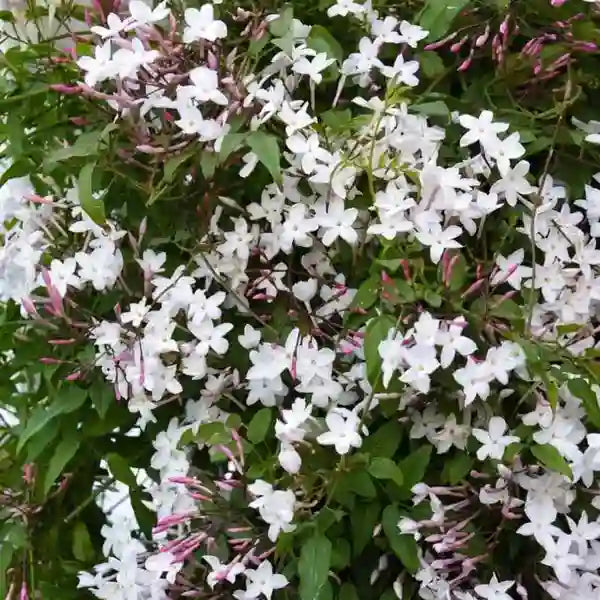
Jasminum Grandiflorum, Pichi Mulla
Selling Size : Single Plant | Pot Included | Secure Packing
"Pichi Mulla" is a specific variety of Jasmine, often referring to Jasminum grandiflorum (also known as Spanish Jasmine or Royal Jasmine). It's highly prized for its intensely fragrant white flowers. "Jasmine" is a broad term encompassing many species within the genus Jasminum.
Since Pichi Mulla is a type of Jasmine, the care requirements are largely similar to general Jasmine care, but with some specific nuances.
Here's a combined and detailed care guide for Pichi Mulla and other Jasmines :
1. Light:
Full Sun to Partial Shade: Most jasmines, including Pichi Mulla, thrive in full sun, meaning at least 6 hours of direct sunlight daily. This is essential for abundant flowering.
Protection from Harsh Afternoon Sun: In hotter Indian climates, especially during peak summer, intense afternoon sun can be too much. Providing partial shade during the hottest part of the day (e.g., in the afternoon) can prevent leaf scorch and heat stress, particularly for potted plants. A location that gets morning sun and afternoon shade is often ideal.
2. Soil:
Well-Draining and Rich in Organic Matter: Jasmine plants are very sensitive to waterlogging. The soil must drain exceptionally well. They also prefer fertile soil.
Ideal Mix: A good mix for potted plants would be:
Garden soil or loamy soil
Plenty of well-rotted compost or farmyard manure (FYM)
Sand, perlite, or coco peat to improve drainage and aeration.
pH: Slightly acidic to neutral (pH 6.0-7.0) is generally preferred.
3. Watering:
Consistent Moisture, Not Soggy: Water regularly, keeping the soil consistently moist but never waterlogged.
"Finger Test": Water when the top 1-2 inches of soil feel dry to the touch.
Thorough Watering: When you water, do so deeply until water drains from the bottom of the pot (for potted plants).
Reduce in Dormancy/Winter: During cooler months or when the plant's growth slows (dormancy), reduce watering frequency.
Avoid Wetting Foliage: Try to water at the base of the plant to minimize wetting the leaves, as prolonged wetness can encourage fungal diseases.
4. Temperature and Humidity:
Warm and Tropical: Jasmines, being tropical plants, prefer warm temperatures, ideally between 20∘C to 30∘C (68∘F to 86∘F).
Frost Sensitive: Protect them from frost or temperatures below 10∘C (50∘F). If growing in a region with cold winters, consider growing in pots that can be moved indoors.
High Humidity: They appreciate high humidity. In dry environments:
Mist the foliage regularly (especially in the mornings).
Place the pot on a pebble tray filled with water (ensure the pot isn't sitting in the water).
Group plants together to create a localized humid microclimate.
5. Fertilization:
During Growing Season (Spring to Summer/Monsoon): Fertilize regularly every 2-4 weeks.
Use a balanced liquid fertilizer (e.g., NPK 10-10-10 or 20-20-20) diluted to half strength.
For Pichi Mulla and other flowering jasmines, once buds start forming, you can switch to a fertilizer higher in phosphorus and potassium to encourage more blooms (e.g., NPK 5-10-10 or 10-20-20).
Organic Options: Supplement with organic manures like well-rotted cow dung, compost, or neem cake every 1-2 months.
Reduce in Winter: Stop or significantly reduce fertilizing during the cooler months when the plant's growth slows down.
6. Pruning:
Pinching (for Bushier Growth): When the plant is young, pinch back the tips of new growth to encourage branching and a bushier habit, which leads to more flowers.
Deadheading: Regularly remove faded or spent flowers (deadhead) to encourage the plant to produce more blooms and prolong the flowering season.
Post-Flowering Pruning: This is crucial for Jasmines. After the main flowering season is over (usually late autumn/early winter, depending on the variety), perform a significant prune.
Cut back old, woody, and unproductive stems.
Trim back the plant to maintain its desired size and shape. For vine varieties, this is also when you can train them on supports.
Pruning stimulates new growth, and since jasmine flowers on new wood, this ensures a good flush of blooms in the next season.
Remove Diseased/Damaged Branches: Always remove any dead, diseased, or damaged branches immediately.
7. Support (for Climbing Varieties):
Many popular jasmine varieties, including Pichi Mulla (Jasminum grandiflorum), are climbing vines. They will need a support structure like a trellis, arbor, fence, or wall to climb on.
Gently tie young vines to the support to guide their growth.
8. Propagation:
Cuttings: This is the most common and easiest method. Take semi-hardwood cuttings (about 6-8 inches long) from healthy, non-flowering stems, remove lower leaves, and root them in a well-draining potting mix or water. Rooting hormone can increase success rates.
Layering: Ground layering is also an effective method.
9. Pests and Diseases:
Common Pests: Watch out for aphids, spider mites, mealybugs, and whiteflies.
Control:
Regular inspection.
Hose off with a strong jet of water for minor infestations.
Use neem oil spray or insecticidal soap for more persistent issues.
Diseases: Root rot (due to overwatering/poor drainage) and fungal leaf spots (due to high humidity/poor air circulation) are common.
Prevention: Ensure good drainage, avoid overhead watering, and provide adequate air circulation.
Special Notes for Pichi Mulla (Jasminum grandiflorum):
Flowering Season: Pichi Mulla typically blooms profusely from late spring through summer and into autumn, with flushes of flowers.
Fragrance: Its fragrance is particularly strong and sweet, making it a popular choice for garlands, perfumes, and just enjoying in the garden.
By following these guidelines, you can ensure your Pichi Mulla and other Jasmine plants thrive and provide you with their exquisite fragrance and beautiful blooms.

